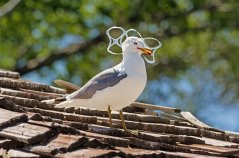
In the spotlight
Preventing litter
Children and adults throughout the Netherlands were hard at work with long tongs and rubbish bags on the latest 'landelijke Opschoondag' (national clean-up day) organised by the 'Nederland Schoon' (a clean Netherlands) foundation. They cleared up bags full of litter from the streets, parks, verges and woods. The majority of this litter consists of packaging materials such as biscuit, crisp and snack packets, as well as empty cans and bottles.

Many people find this scattered litter extremely annoying. After all, we all feel happier in clean surroundings. Moreover, litter also attracts dirt and is detrimental to nature and the environment. Litter can pollute the soil and animals can mistake it r for food or become entangled in it. In contrast to banana skins, which can decompose within a year, chewing gum takes at least twenty years to break down and cans more than fifty years – while plastic bottles may just fall apart into increasingly small pieces.
Approach to litter
Dutch nature and environmental education centres (NMEs) strive to make children, young people and adults aware of the value of an environment without litter and so try to prevent littering. However, which substantive, design and layout requirements need to be met by teaching material that can achieve the intended improvements in knowledge, attitudes and behaviour?

The approach to litter needs to be integrated in our schools' culture
The amount of litter in our environment can be reduced only when we improve our knowledge, attitudes and behaviour. Studies of litter teaching packages carried out by the Wageningen University & Research Science Shop offer guidelines for the development of effective teaching material.
The researchers made comparisons of teaching packages, carried out literature studies and sought expert views for their development of a checklist for effective teaching packages. Bram ten Cate, project manager at Wageningen Environmental Research, explains that 'Nature and environmental education centres and teachers can use this checklist (Dutch)to assess and improve their teaching materials.'
Personal initiative
Anne Remmerswaal, a researcher at the Wageningen University & Research Education and Competence Studies Group, who was involved in the studies, says 'Teaching materials must offer pupils scope to take personal initiatives. Lessons on the prevention of litter need to focus on these personal initiatives. Preventing litter begins with us. All too often, teaching materials concentrate on the creation of awareness and on discussions of the problem and potential approaches to a solution, rather than on actually doing something about it. Pupils who take personal initiatives realise that they really can make a difference.'
'Green heroes'
A second recommendation from the studies is that teaching materials need to offer inspiration. According to Anne Remmerswaal, 'Pupils need inspiring examples – green heroes – preferably children who got to work on clearing up litter.' These green heroes include Boyan Slat, who as a child found the solution for clearing up the plastic soup in the seas and is now, with his The Ocean Cleanup foundation, working on the implementation of his idea.
Structural
The researchers also stress that a structural approach needs to be adopted to lessons on litter and the attention given to litter. 'Schools need to repeat the lessons at regular intervals and introduce systems for the separation of their waste. The approach to litter needs to be integrated in our schools' culture,' Bram ten Cate says. 'We shouldn't talk in terms of changes in behaviour, but rather in terms of changes in habits and of the development of values.'
About Bram ten Cate
Bram, a communication and quality policy officer, is active in areas including the communication of the results from nature and environmental research. He is also a project manager at the Wageningen University & Research Science Shop.